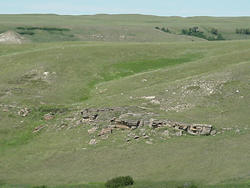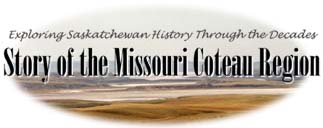 Dr.
Ernie Walker archeologically dug the jump in 1988. The use of
a backhoe on the talus slope directly below the sandstone drop
off was required. Uncovering the jump revealed that the site had
been used numerous times in the last five thousand years, (though
not on a yearly basis).
Dr.
Ernie Walker archeologically dug the jump in 1988. The use of
a backhoe on the talus slope directly below the sandstone drop
off was required. Uncovering the jump revealed that the site had
been used numerous times in the last five thousand years, (though
not on a yearly basis).
 People
needed to eat, and the buffalo were plentiful. Many things that
were needed for everyday life were provided from buffalo alone.
They were used for various things such as clothing, tools, food,
and decoration. They were heavily relied on and were very important
for human survival at that time.
People
needed to eat, and the buffalo were plentiful. Many things that
were needed for everyday life were provided from buffalo alone.
They were used for various things such as clothing, tools, food,
and decoration. They were heavily relied on and were very important
for human survival at that time.
 Getting
ready for a hunt as large as this required forward planning. It
is estimated that a group of nearly one thousand people, (including
children) were necessary to properly manage and process the results
of the slaughter.
Getting
ready for a hunt as large as this required forward planning. It
is estimated that a group of nearly one thousand people, (including
children) were necessary to properly manage and process the results
of the slaughter. It is reasonable to assume that several tribes needed to co-ordinate
their efforts to make a success of the drive.
It is reasonable to assume that several tribes needed to co-ordinate
their efforts to make a success of the drive.
 When
tribes were too small to hunt the buffalo in this fashion, they
used alternate methods. They could chase the animals into a barricade
or a corral located in a steep sided ravine. When they were captured,
many of the animals could be attacked and slaughtered at one time.
When
tribes were too small to hunt the buffalo in this fashion, they
used alternate methods. They could chase the animals into a barricade
or a corral located in a steep sided ravine. When they were captured,
many of the animals could be attacked and slaughtered at one time.
 Dr.
Walker's report states that for a kill of such a large scope several
weeks would be spent by "herders" creeping amongst the herds.
"Herders" were dressed in coyote skins. Their job was to gather
bison from as much as twenty miles (32 kilometers) away. In the
meantime, workers at the kill site would be busy doing various
jobs. They would burn off the grass at the base of the precipice,
dig pits lined with a bed of stones to hold heat for processing,
gather brush and wood for fires, and build (or rebuild) small
posts for fencing to help guide or funnel the animals toward the
precipice.
Dr.
Walker's report states that for a kill of such a large scope several
weeks would be spent by "herders" creeping amongst the herds.
"Herders" were dressed in coyote skins. Their job was to gather
bison from as much as twenty miles (32 kilometers) away. In the
meantime, workers at the kill site would be busy doing various
jobs. They would burn off the grass at the base of the precipice,
dig pits lined with a bed of stones to hold heat for processing,
gather brush and wood for fires, and build (or rebuild) small
posts for fencing to help guide or funnel the animals toward the
precipice.
 At
this kill site small piles of stones were set out to hold branches
and sticks for "fencing" in the animals. These branches and sticks
fanned out in two directions. They went to the northeast and the
southeast for one and a half miles; (agriculture usage has obliterated
any further extensions there may have been). Two smoke signal
sites about 14 miles (24 kilometers) to the northeast may be related
to the drive.
At
this kill site small piles of stones were set out to hold branches
and sticks for "fencing" in the animals. These branches and sticks
fanned out in two directions. They went to the northeast and the
southeast for one and a half miles; (agriculture usage has obliterated
any further extensions there may have been). Two smoke signal
sites about 14 miles (24 kilometers) to the northeast may be related
to the drive.
 To
prepare the stone lined pits for processing a fire would be made
on the stones. They would allow for sufficient time to thoroughly
heat these stones. Then they would be dowsed and a buffalo hide,
with hair removed would be placed over the pit filled with the
material to be rendered. Then it was covered with "hair on" hides
for insulation to hold the heat in for an indeterminate length
of time.
To
prepare the stone lined pits for processing a fire would be made
on the stones. They would allow for sufficient time to thoroughly
heat these stones. Then they would be dowsed and a buffalo hide,
with hair removed would be placed over the pit filled with the
material to be rendered. Then it was covered with "hair on" hides
for insulation to hold the heat in for an indeterminate length
of time. This method is very similar to that used in cooking an Hawaiian
luau. No doubt that after a 45-foot (15 meter) drop onto other
animals some bison may be able to escape. If a drive in the fall
had an excess of mild weather it is reasonable to assume that
all the meats could not be processed in time before spoilage.
This method is very similar to that used in cooking an Hawaiian
luau. No doubt that after a 45-foot (15 meter) drop onto other
animals some bison may be able to escape. If a drive in the fall
had an excess of mild weather it is reasonable to assume that
all the meats could not be processed in time before spoilage.
 Large
bones of bison were broken open to obtain the marrow. The marrow
was very nutritious, but more importantly acted as a preservative
for making pemmican.
Large
bones of bison were broken open to obtain the marrow. The marrow
was very nutritious, but more importantly acted as a preservative
for making pemmican.

